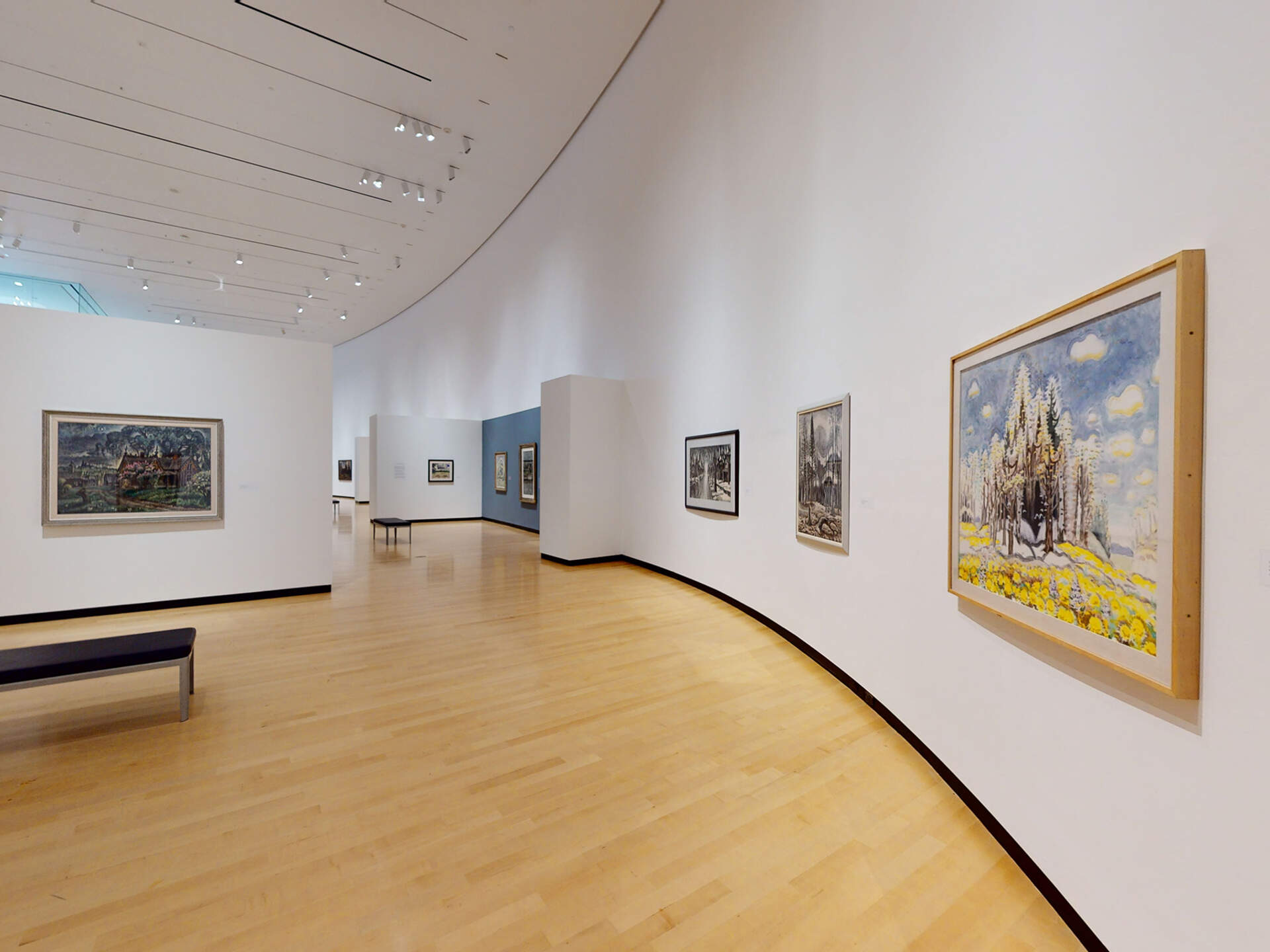
Charles E. Burchfield: A Lifetime of Themes
Past
Dec 10, 2021 - May 1, 2022
“My mind is on fire…and ideas crowd tumultuously upon each other” — Charles E. Burchfield, 1964
At the height of his painting frenzy in the mid-1960s, Charles Ephraim Burchfield reflected upon a half century’s work as an artist. Recurring themes had been investigated in an evolving and increasingly complex approach to expression. Nature’s transcendental beauty, awe-inspiring power, and vibrancy remained preeminent. Weather fluctuations, seasonal transitions, and the creation of symbols to articulate human emotions and sound all factored into his visualization of experiences he felt compelled to share. Environmental concerns born from his youthful proximity to coal mines, coke smelting, and other industries in Ohio made evident habitat pollution and human destruction. Art school exposure to landscapes in Japanese prints and Chinese scroll paintings contributed conceptually to his painting compositions from 1915 onward. Academic grounding in illustration and design facilitated his brief career designing wallpapers in the 1920s. He revealed aspects of small-town American life that was disappearing. His urban scenes played society’s romanticized notions of locomotive power and idealized industrial expansion against the insurmountable toll taken on the land itself.
The Frank K. M. Rehn Galleries in New York City started to represent Burchfield in 1929 and his career soared. In April 1930, he had the honor of being the first artist to have a solo exhibition at the nascent Museum of Modern Art, where Director Alfred H. Barr, Jr. recognized the unique character of Burchfield’s early art, writing, “One can only conclude that we have in this period of Burchfield’s development one of the most isolated and original phenomena in American Art.”
Over the course of his career, his unique watercolor painting style became increasingly complex, evolving from modernist abstraction to romantic realism to transcendental visionary landscapes. He aspired to share his experiences by depicting sights, sounds, and even aromas in his work. During his lifetime, Burchfield was given more than 70 solo exhibitions and his work was shown in hundreds of exhibitions—some traveling internationally. He received many prestigious awards and prizes that validated extensive appreciation of his art. Accolades included posthumous praise from the President of the United States. More than 150 public institutions and hundreds of private collectors own his work. Our namesake museum was created in Buffalo, New York on December 9, 1966, one of the first dedicated museums in the world to be opened when the artist was still alive.
What makes Burchfield so intriguing is his adaptability and growth, exploring techniques and subjects not attempted by others. Because his distinctive work remains relevant to this day, it excites new audiences in the 21st century. Contemporary visual artists, composers, and authors have expressed great interest in Burchfield’s work, even if their own art form manifests differently. Notably this includes Robert Gober, Jenny Holzer, Nell Shaw Cohen, Janelle Lynch, James Welling, Eric Aho, Rebecca Allan, Josh Dorman, and Peter Rock, among many others.
As a result, the Burchfield Penney Art Center organized a major retrospective exhibition to present highlights from the arc of Burchfield’s lifetime of themes, including many of the works that were part of the celebratory “Fifty Years as a Painter” in Charles Burchfield: His Golden Year—A Retrospective Exhibition of Watercolors, Oils and Graphics, organized by the University of Arizona Art Gallery in Tucson in 1965. These are artworks that he believed best represented the subjects and stylistic stages from his junior year in the Cleveland School of Art in 1915 until his most current work in 1965, just a little more than a year before the inauguration of the Charles Burchfield Center in December 1966 and his unexpected death in January 1967.
Charles E. Burchfield: A Lifetime of Themes presented a comprehensive survey of the artist’s work in all media that filled not only the Burchfield suite of galleries, but also extended into the grand East Gallery. Recurrent themes included seasons and weather, landscape’s vulnerability and awesome beauty, a sense of place ranging from neighborhood yards to pristine woods, and spiritual symbolism. Works were borrowed from museums and private collections across the country. Burchfield Scholar Nancy Weekly curated the exhibition with assistance of Curator Tullis Johnson. They are overseeing production of an accompanying digital and print publication. The program was supported in part from the generous funds of the Charles E. Burchfield Foundation, Inc.
Looking back on all he accomplished, Charles Burchfield wrote: “Every so often, when a new idea for a manner of working comes to me, I have the feeling that I am just learning how to paint. It is as if there is a veil between me and the ultimate in painting, and only bit by bit am I allowed to penetrate the mystery beyond that veil.” This exhibition lifted that veil to show how he did reach the ultimate in painting.
This exhibition was presented by The Tower Family Fund, Inc., and The Charles E. Burchfield Foundation, with generous support from Paula & John Reinhold and The Joy Family Foundation, The Robert & Patricia Colby Foundation, The Carlos & Elizabeth Heath Foundation, The Mulroy Family Foundation, The Vogt Family Foundation at the Community Foundation for Greater Buffalo, The Baird Foundation, Steve Lakomy, MD & Cheryl Lyles. James & Michal Wadsworth, and Janet M. & Richard H. Wetter. Additional support came from Jessica & David Brason, John & Candace Darby, Shelley C. Drake, in memory of Kenneth C. Drake, Mrs. John Kociela, Gina & Erik O'Neill, and Debbie & Chris Malof.